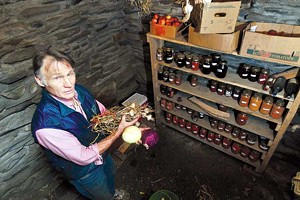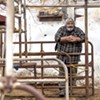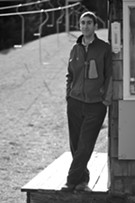Published May 13, 2009 at 4:29 a.m.
Now probably isn’t the easiest time to get excited about storing produce for the winter. After all, the trees are finally in bloom, peas are coming up, and we have a summer of fresh, abundant local food to look forward to.
But if you point your gaze a few months beyond those bright days of fecundity, you stare once again into the long tunnel of fallow winter. For most of us, that means a return to at least partial dependence on food trucked or flown here from other climes. And with it the arrival of that green-tinged angel on your shoulder — the one that makes you feel guilty about the carbon footprint of, say, your crispy Chilean apples.
“You’re contributing to global warming,” whispers the angel in your ear. “What about food security?” it asks. “Peak oil is upon us!” the angel shouts. “Wake up!”
Maybe you’re not plagued by this annoying little voice. Or maybe you just ignore it and get on with your busy life. But if you’re wondering whether there’s a low-energy way to store local produce through a Vermont winter, there is: It’s called root cellaring.
Although the name seems self-explanatory, “There is more to root cellaring than just throwing a bunch of root vegetables into the basement and hoping for the best,” says Richard Czaplinski, a retired engineer who’s a member of the Post-Carbon Sustainability Network (PocSun), a group that works in conjunction with Transition Town Montpelier.
The Transition Town movement, which began in the United Kingdom in 2005, is devoted to educating communities about how to relocalize their economies in preparation for the challenges of energy shortages and climate change. PocSun, which shares that mission, recently decided to focus on teaching and disseminating root-cellaring skills over the next two years. Czaplinski’s doing his part for the initiative; he’s written a six-page guide to root cellaring and offers free consultations with people who need help siting and building their own.
On a cool, sunny spring Sunday morning, Donna O’Malley decides to take Czaplinski up on his offer. O’Malley, 52, has long, wavy hair the color of weathered granite and works for the AmeriCorps Neighbor to Neighbor program. Her goal is to “grow food and store it” at her off-the-grid homestead in Calais. She and her friend Don Lenz, 55, a builder from Plainfield, have come to Czaplinski’s cabin to get a guided tour of his root cellar and learn some principles of food storage.
Czaplinski, 67, has brown hair, white sideburns and light blue eyes and looks at least 15 years younger than he is. He meets O’Malley and Lenz wearing jeans, a pink Oxford shirt and running shoes. Czaplinski has been using a root cellar for as long as he can remember. His parents had one on the dairy farm in Wisconsin where he grew up.
“It’s in my hands,” he says of cellar digging. When he built his home on Sodom Pond in Adamant, he designed it literally from the ground up, starting with where he’d put the root cellar. Down the hill from his house is a mature orchard with apple, pear and plum trees, along with a terraced garden enclosed by a high fence. Much of his diet is harvested within 100 yards of his back stoop.
As O’Malley and Lenz walk into the kitchen, warm from the wood-burning cook stove, Czaplinski notes that his current main purpose in life is to show people scaling down is possible. “People are very afraid,” he says. “I tell them to relax.” He also tells them that using less energy in the food system isn’t just sensible — it can be fun.
Czaplinski opens a trap door in the floor and leads his visitors down into the root cellar. The room is about 64 square feet and 7 feet high, with a hard dirt floor and walls of masonry and fieldstone.
Czaplinski explains that a good root cellar will have at least one north wall and dirt all the way up to the top of the foundation. “You want the cold earth behind these walls,” he instructs.
The earth keeps the room cold in the fall and spring, but warm enough in the winter so the produce doesn’t freeze. There are two windows at head height, one of which Czaplinski uses to modulate the temperature. In the fall and spring, he opens it at night to let the cool air seep in. In the winter, both windows remain closed and boarded against the light.
Different vegetables have different ideal storage temperatures. The basic root vegetables — carrots, beets, parsnips, celeriac and leeks — prefer 32 degrees with 95 percent humidity. Apples like the same conditions, but they need to be segregated and sealed because they give off ethylene, which causes the other produce to ripen more quickly. Czaplinski keeps his Prairie Spies in a cardboard box and layers the apples with newspaper. He looks around for one to share with his guests. “You can see some of them are starting to go by,” he says, “but some of them are perfectly good.”
Along the walls, wooden shelves hold a variety of canned produce, such as apple sauce, apple butter, raspberry jam, tomato juice, spaghetti sauce and pears. Onions hang from the ceiling, and buckets filled with beets, carrots, celeriac and potatoes are scattered around the floor. Potatoes like temps a little warmer, at 40 degrees and 95 percent humidity.
“Temperature, humidity and ventilation are the heart of the art,” Czaplinski says, noting there are simple ways to control all three. A thermometer and hygrometer will cover the first two, but if you want to open your trap door and know right off how cold it is, Czaplinski recommends keeping a shallow bucket of water on the ground. If you’ve got ice, it’s too cold. “That’s easy!” declares O’Malley.
It gets below freezing in the cellar about twice a year, which is why Czaplinski installed a fan in the ceiling that draws warm air from the first floor when he needs it.
Some vegetables — cabbage and peppers, for example — will only keep for two months, so Czaplinski advises that the “combination of a root cellar and a greenhouse is critical.” Czaplinski’s own greenhouse extends from his basement to the south side of the house. He extracts cabbage and peppers from the garden in the fall, with the root balls intact, and replants them in the greenhouse, where they stay in a kind of suspended animation until about Christmas time. The cabbages can then be transferred into the root cellar, but the peppers should be consumed. Chard and kale are hearty enough to overwinter in the greenhouse, where it gets well below freezing, and then start to grow again in the early spring.
Back in the kitchen, Czaplinski reminds O’Malley and Lenz that a root cellar is just one component of a well-functioning food system. Dried beans, grains and squash, for example, can stay in a cold-storage room in an unheated part of the house.
Czaplinski’s resembles the typical root cellar that was used in Vermont farmhouses throughout the 18th and 19th centuries, but other styles work, too. Say you don’t have a basement. In that case, a hole in the ground or a space dug out of a slope can work, when insulated properly. The humidity is actually easier to control when three sides of the cellar are encased in earth. But the cellar needs to be accessible during the snowy months. “If it’s hard to get to, you’re not going to use it,” Czaplinski warns. “You want to make it easy.”
Homeowners who have a conventional basement with concrete floors and a furnace can frame off a separate corner, preferably with a window for ventilation, insulate it with Styrofoam blueboard, and keep it moist with a mister or a pan of water.
Of course, those who don’t have long-term storage for root vegetables can still buy them from those who do — through a CSA or winter farmers market. The Montpelier market features root vegetables from Pete’s Greens and Blackwell Roots Farm, among others.
Lee Blackwell, 56, and his wife, Ruth Richards, 55, are in their third season of cultivating and storing root vegetables at their end-of-the-road farm in Cabot. On a recent rainy Thursday afternoon, Blackwell is just getting up from a nap after feverishly planting onions in the good weather.
Blackwell Roots grows and stores about 6 tons of carrots, 4 tons of potatoes and 1.5 tons of onions. To keep this much produce through the winter, Blackwell, a former carpenter, built a barn that backs up to the side of a hill. It has separate 9-foot-tall root-cellar environments for carrots, onions and potatoes. Besides selling the vegetables, Blackwell Roots makes kimchi, an organic lacto-fermented Korean sauerkraut made of green cabbage, Napa cabbage, bok choy, leeks, carrots, daikon, garlic, red pepper and ginger, all of which grow on the farm.
Blackwell is soft-spoken and deliberate, his brown hair hidden beneath a short-brimmed brown cap. He’s been in the farming business one way or another for 30 years, but recently decided to recommit to it full time. “It seemed like the local food movement was taking off, and there was a possibility of making a living farming,” he explains.
Why root vegetables? “It was a niche that nobody was exploiting,” Blackwell says. A timely one, too. He cites a recent Wall Street Journal report that world oil production has peaked, and says that “our food system is going to have to change, because it’s completely dependent on fossil fuel.”
With that in mind, Blackwell is doubling his production this summer, to two acres. But don’t label him a doomsday prophet — like Czaplinski, he enjoys his work and thinks it’s pretty practical to have a year-round local food supply.
“I think it’s the thing I was meant to do,” Blackwell says ruminatively. “I’ve never been happier, and I haven’t been more tired.”
Home and Garden Issue
Mud season is over, spring has sprung, and all across the state Vermonters are … back in the dirt. Soil, that is. Tilling it, planting flowers and food in it, and, in the case of the Vermont Compost Co., selling it. In this issue we go indoors to consider low-budget decorating tips and eco-friendly window treatments; outdoors to visit a profitable Vermont farm and a wannabe eco village; and underground to a root cellar. Finally, master gardener Barbara Richardson talks container crops, because not all of us can plot our produce. No place like home.
This is just one article from our May 13, 2009 Home and Garden Issue. Click here for more Home and Garden stories.
More By This Author
Speaking of...
-

Q&A: Howard Fisher Delivers Meals on Wheels With a Side of Good Cheer
Dec 20, 2023 -

Video: Howard Fisher Delivers Meals on Wheels
Dec 14, 2023 -

Q&A: Alexis Dexter Rescued 57 Shelter Cats During the July Flood
Sep 13, 2023 -

Video: Two Months After the Flood, Alexis Dexter Rebuilds Kitty Korner Café in Barre and Continues to Rescue Cats
Sep 7, 2023 -

Did Your Garden Flood? Here's What to Know
Jul 28, 2023 - More »
Comments
Comments are closed.
From 2014-2020, Seven Days allowed readers to comment on all stories posted on our website. While we've appreciated the suggestions and insights, right now Seven Days is prioritizing our core mission — producing high-quality, responsible local journalism — over moderating online debates between readers.
To criticize, correct or praise our reporting, please send us a letter to the editor or send us a tip. We’ll check it out and report the results.
Online comments may return when we have better tech tools for managing them. Thanks for reading.















































